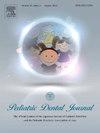Deciduous teeth eruption, gross motor skills, and feeding in children with down syndrome: A cross-sectional study
IF 0.8
Q4 DENTISTRY, ORAL SURGERY & MEDICINE
引用次数: 0
Abstract
Introduction
Down syndrome (DS) is often associated with delayed teeth eruption, gross motor skill acquisition, and feeding difficulties. In typically developing (TD) children, changes in weaning food texture with deciduous teeth eruption and motor skill acquisition, which improves feeding skills. However, in DS, these processes are delayed, and age alone is not a reliable predictor for such changes. Therefore, we investigated the association between these parameters in children with DS.
Methods
We administered questionnaires to parents of 56 children with DS aged 0–3 years. The survey items included timing of deciduous tooth eruption, physical development, acquired gross motor skills, and texture of weaning foods being consumed. The included children were allocated to two groups according to the confirmed eruption of mandibular deciduous central incisor by or after 12 months.
Results
The groups significantly differed in height, Kaup index, and acquisition age of pulling to stand, as determined by Mann–Whitney U test. Furthermore, multiple regression analysis revealed a significant association between the age of mandibular central incisor eruption and height along with that of acquisition age of pulling to stand. However, no significant difference was observed in the texture of weaning foods.
Conclusion
The observed associations between the eruption of mandibular central incisor, height, and acquisition age of pulling to stand suggest an association between teeth eruption, physical development, and motor development. Despite no differences in weaning food texture, most patients developed dysphagia habilitation, indicating the need to adjust food texture based on delays in physical and motor development.
唐氏综合症儿童乳牙萌出、粗大运动技能和喂养:一项横断面研究
唐氏综合症(DS)通常与牙齿长出延迟、大运动技能获得和喂养困难有关。在典型发育(TD)儿童中,断奶食物质地随着乳牙的长出和运动技能的习得而改变,从而提高喂养技能。然而,在退行性痴呆中,这些过程延迟,年龄本身并不是这些变化的可靠预测因子。因此,我们研究了这些参数在儿童退行性椎体滑移中的相关性。方法对56例0 ~ 3岁DS患儿家长进行问卷调查。调查项目包括乳牙萌出的时间、身体发育、获得的大肌肉运动技能和断奶食物的质地。根据12个月前或12个月后确定的下颌乳牙中切牙萌出情况分为两组。结果经Mann-Whitney U检验,各组在身高、Kaup指数、拔立习得年龄上存在显著差异。多元回归分析显示,下颌中切牙出牙年龄与身高、拔立获得年龄有显著相关性。然而,断奶食物的质地没有显著差异。结论下颌中切牙萌出与身高、拔立年龄的关系提示萌出与身体发育、运动发育有关。尽管在断奶时食物质地没有差异,但大多数患者出现吞咽困难适应,这表明需要根据身体和运动发育的延迟来调整食物质地。
本文章由计算机程序翻译,如有差异,请以英文原文为准。
求助全文
约1分钟内获得全文
求助全文
来源期刊

Pediatric Dental Journal
DENTISTRY, ORAL SURGERY & MEDICINE-
CiteScore
1.40
自引率
0.00%
发文量
24
审稿时长
26 days
 求助内容:
求助内容: 应助结果提醒方式:
应助结果提醒方式:


